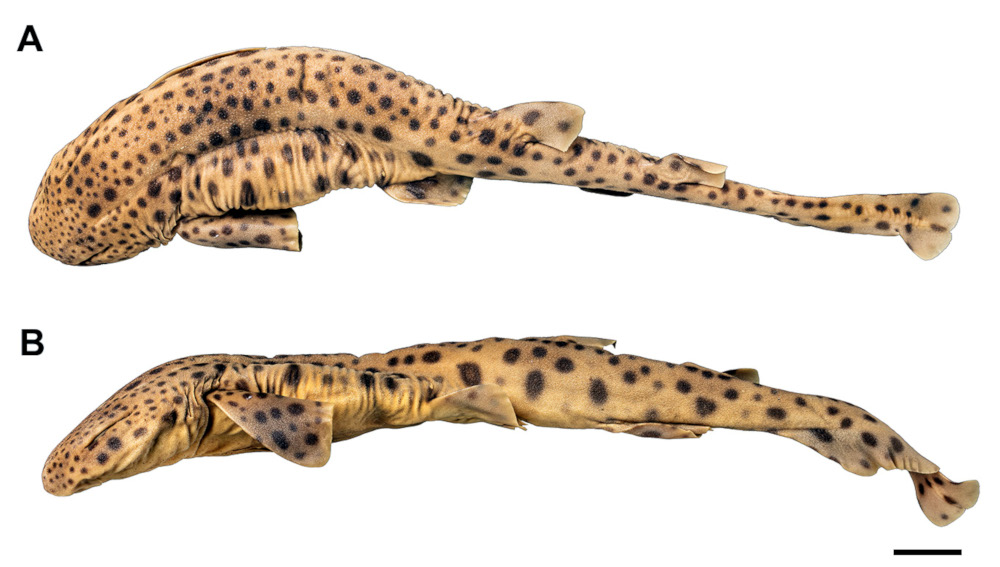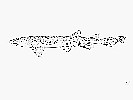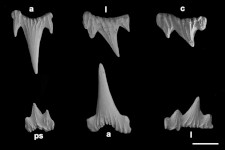Scyliorhinus stellaris
(Linnaeus, 1758)
Nursehound
Classification: Elasmobranchii Carcharhiniformes Scyliorhinidae
Reference of the original description
Systema Naturae per regna tria naturae, regnum animale, secundum classes, ordines, genera, species, cum characteribus differentiis synonymis, locis. Tomus I. Editio decima, reformata. Stockholm, Laurentii Salvii, 824pp.
Systema Naturae per regna tria naturae, regnum animale, secundum classes, ordines, genera, species, cum characteribus differentiis synonymis, locis. Tomus I. Editio decima, reformata. Stockholm, Laurentii Salvii, 824pp.
Image of the original description
No image in first description.
No image in first description.
Synonyms / new combinations and misspellings
Catulus stellaris, Galeus stellaris, Poroderma stellare, Scylliorhinus catulus, Scylliorhinus stellare, Scylliorhinus stellaris, Scyllium acanthonotum, Scyllium catulus, Scyllium stellare, Scyllium stellaris, Scyllium stellarius, Squalus stellario, Squalus stellaris
Catulus stellaris, Galeus stellaris, Poroderma stellare, Scylliorhinus catulus, Scylliorhinus stellare, Scylliorhinus stellaris, Scyllium acanthonotum, Scyllium catulus, Scyllium stellare, Scyllium stellaris, Scyllium stellarius, Squalus stellario, Squalus stellaris
Types
Scyliorhinus stellaris
Neotype: BMNH: 1976.7.30.10;
Scyllium acanthonotum
XXXX: no types known;
Scyllium catulus
XXXX: No types known;
Scyliorhinus stellaris
Neotype: BMNH: 1976.7.30.10;
Scyllium acanthonotum
XXXX: no types known;
Scyllium catulus
XXXX: No types known;
Description :
Citation: Scyliorhinus stellaris (Linnaeus, 1758): In: Database of modern sharks, rays and chimaeras, www.shark-references.com, World Wide Web electronic publication, Version 01/2026
Please send your images of "Scyliorhinus stellaris" to info@shark-references.com

Scyliorhinus stellaris (Linnaeus, 1758), neotype, NHMUK 1976.7.30.10, male, 476 mm TL (Banyuls, Pyrenees, France). A, dorsal view; B, lateral view. Scale bar = 20 mm © Karla A. Soares, Laboratório de Ictiologia, Departamento de Zoologia, Instituto de Biociências, Universidade de São Paulo

Scyliorhinus stellaris (Linnaeus, 1758), neotype, NHMUK 1976.7.30.10, male, 476 mm TL (Banyuls, Pyrenees, France). A, dorsal view; B, lateral view. Scale bar = 20 mm © Karla A. Soares, Laboratório de Ictiologia, Departamento de Zoologia, Instituto de Biociências, Universidade de São Paulo
Common names
 Großer Katzenhai,
Großer Katzenhai,  Großgefleckter Katzenhai,
Großgefleckter Katzenhai,  Hundshai,
Hundshai,  Katzenhai,
Katzenhai,  Pantherhai,
Pantherhai,  Alitán,
Alitán,  Breka,
Breka,  Cazó nazopado,
Cazó nazopado,  Gat,
Gat,  Gat vayre,
Gat vayre,  Gata,
Gata,  Gatet,
Gatet,  Gato marino,
Gato marino,  Gatvayra,
Gatvayra,  Gatún,
Gatún,  Lija,
Lija,  Lixa,
Lixa,  Moma,
Moma,  Momarra,
Momarra,  Muxina,
Muxina,  Patarroxa,
Patarroxa,  Pintarroja,
Pintarroja,  Pitarrosa,
Pitarrosa,  Renuda,
Renuda,  Chat-rochier,
Chat-rochier,  Gat rouquin,
Gat rouquin,  Grande roussette,
Grande roussette,  Roussette,
Roussette,  Roussette à grandes taches,
Roussette à grandes taches,  Bull huss,
Bull huss,  Dogfish,
Dogfish,  Flake,
Flake,  Flake catfish,
Flake catfish,  Greate-spotted dogfish,
Greate-spotted dogfish,  Greater spotted dogfish,
Greater spotted dogfish,  Hound,
Hound,  Large-spotted dogfish,
Large-spotted dogfish,  Larger spotted dogfish,
Larger spotted dogfish,  Nurse,
Nurse,  Nurse-hound,
Nurse-hound,  Nursehound,
Nursehound,  Rigg,
Rigg,  Attupardu,
Attupardu,  Barbe,
Barbe,  Barde,
Barde,  Diobarda,
Diobarda,  Gata nostrana,
Gata nostrana,  Gata sciava,
Gata sciava,  Gatta d"argua,
Gatta d"argua,  Gattopardo,
Gattopardo,  Gattu di mari,
Gattu di mari,  Gattu steddari,
Gattu steddari,  Gattubardu,
Gattubardu,  Gattuccio,
Gattuccio,  Gattuccio maggiore,
Gattuccio maggiore,  Gattucia,
Gattucia,  Gattupardu,
Gattupardu,  Gattuso,
Gattuso,  Grande rosetta,
Grande rosetta,  Jattaredda,
Jattaredda,  Jattefarre,
Jattefarre,  Jattolla,
Jattolla,  Jattupaddu "i rocca,
Jattupaddu "i rocca,  Jattuparda,
Jattuparda,  Jattupardu,
Jattupardu,  Labardu,
Labardu,  Liobardo,
Liobardo,  Sgatto,
Sgatto,  Squalo gattopardo,
Squalo gattopardo,  Gata,
Gata,  Pata-roxa-gata,
Pata-roxa-gata,  Pata-roxa-grande,
Pata-roxa-grande,  Patarroxa-gata,
Patarroxa-gata,  Patarroxa-grande, Gattarell tar-Rukkal (malta)
Patarroxa-grande, Gattarell tar-Rukkal (malta)
 Großer Katzenhai,
Großer Katzenhai,  Großgefleckter Katzenhai,
Großgefleckter Katzenhai,  Hundshai,
Hundshai,  Katzenhai,
Katzenhai,  Pantherhai,
Pantherhai,  Alitán,
Alitán,  Breka,
Breka,  Cazó nazopado,
Cazó nazopado,  Gat,
Gat,  Gat vayre,
Gat vayre,  Gata,
Gata,  Gatet,
Gatet,  Gato marino,
Gato marino,  Gatvayra,
Gatvayra,  Gatún,
Gatún,  Lija,
Lija,  Lixa,
Lixa,  Moma,
Moma,  Momarra,
Momarra,  Muxina,
Muxina,  Patarroxa,
Patarroxa,  Pintarroja,
Pintarroja,  Pitarrosa,
Pitarrosa,  Renuda,
Renuda,  Chat-rochier,
Chat-rochier,  Gat rouquin,
Gat rouquin,  Grande roussette,
Grande roussette,  Roussette,
Roussette,  Roussette à grandes taches,
Roussette à grandes taches,  Bull huss,
Bull huss,  Dogfish,
Dogfish,  Flake,
Flake,  Flake catfish,
Flake catfish,  Greate-spotted dogfish,
Greate-spotted dogfish,  Greater spotted dogfish,
Greater spotted dogfish,  Hound,
Hound,  Large-spotted dogfish,
Large-spotted dogfish,  Larger spotted dogfish,
Larger spotted dogfish,  Nurse,
Nurse,  Nurse-hound,
Nurse-hound,  Nursehound,
Nursehound,  Rigg,
Rigg,  Attupardu,
Attupardu,  Barbe,
Barbe,  Barde,
Barde,  Diobarda,
Diobarda,  Gata nostrana,
Gata nostrana,  Gata sciava,
Gata sciava,  Gatta d"argua,
Gatta d"argua,  Gattopardo,
Gattopardo,  Gattu di mari,
Gattu di mari,  Gattu steddari,
Gattu steddari,  Gattubardu,
Gattubardu,  Gattuccio,
Gattuccio,  Gattuccio maggiore,
Gattuccio maggiore,  Gattucia,
Gattucia,  Gattupardu,
Gattupardu,  Gattuso,
Gattuso,  Grande rosetta,
Grande rosetta,  Jattaredda,
Jattaredda,  Jattefarre,
Jattefarre,  Jattolla,
Jattolla,  Jattupaddu "i rocca,
Jattupaddu "i rocca,  Jattuparda,
Jattuparda,  Jattupardu,
Jattupardu,  Labardu,
Labardu,  Liobardo,
Liobardo,  Sgatto,
Sgatto,  Squalo gattopardo,
Squalo gattopardo,  Gata,
Gata,  Pata-roxa-gata,
Pata-roxa-gata,  Pata-roxa-grande,
Pata-roxa-grande,  Patarroxa-gata,
Patarroxa-gata,  Patarroxa-grande, Gattarell tar-Rukkal (malta)
Patarroxa-grande, Gattarell tar-Rukkal (malta)
Short Description
Diagnosis after Compagno, 1984 [517]: Field Marks : A large, fairly stocky, catshark with large and small black spots and sometimes white spots covering dorsal surface, saddle markings obsolete, small anterior nasal flaps that do not reach mouth, no nasoral grooves, labial furrows on lower jaw only, second dorsal fin much smaller than first. Diagnostic Features : Head and body moderately broad. Greatest width of head about 2/3 of head length; no nasoral grooves; anterior nasal. flaps not expanded and falling just short of mouth. First dorsal origin opposite pelvic insertions; second dorsal origin well anterior to anal insertion; interdorsal space subequal or less than anal base. Denticles fairly large and semierect, surface of skin relatively rough. Colour pattern of numerous small and large black spots sometimes interspersed with white spots, the large spots often irregular, subangular, and sometimes expanded into large blotches that may totally cover the body in some individuals; saddle markings indistinct or absent. Size large, adults to 1.6 m.
Diagnosis after Compagno, 1984 [517]: Field Marks : A large, fairly stocky, catshark with large and small black spots and sometimes white spots covering dorsal surface, saddle markings obsolete, small anterior nasal flaps that do not reach mouth, no nasoral grooves, labial furrows on lower jaw only, second dorsal fin much smaller than first. Diagnostic Features : Head and body moderately broad. Greatest width of head about 2/3 of head length; no nasoral grooves; anterior nasal. flaps not expanded and falling just short of mouth. First dorsal origin opposite pelvic insertions; second dorsal origin well anterior to anal insertion; interdorsal space subequal or less than anal base. Denticles fairly large and semierect, surface of skin relatively rough. Colour pattern of numerous small and large black spots sometimes interspersed with white spots, the large spots often irregular, subangular, and sometimes expanded into large blotches that may totally cover the body in some individuals; saddle markings indistinct or absent. Size large, adults to 1.6 m.
Distribution
Balearic and Tyrrhenian Seas, in the continental shelves of Italy, Tunisia, France and Spain, with two records in the Adriatic Sea close to Venice, Italy, and Rovinj, Croatia. Also found along the Northeastern Atlantic in the continental shelves of Portugal, France and the United Kingdom, as well as one record for the North Sea (55ºN, 3ºE). No records exist from northwestern Africa [27296] Source: www.gbif.org
Balearic and Tyrrhenian Seas, in the continental shelves of Italy, Tunisia, France and Spain, with two records in the Adriatic Sea close to Venice, Italy, and Rovinj, Croatia. Also found along the Northeastern Atlantic in the continental shelves of Portugal, France and the United Kingdom, as well as one record for the North Sea (55ºN, 3ºE). No records exist from northwestern Africa [27296] Source: www.gbif.org
Human uses
fisheries: minor commercial; aquarium: public aquariums; price category: medium; price reliability: reliable: based on ex-vessel price for this species
fisheries: minor commercial; aquarium: public aquariums; price category: medium; price reliability: reliable: based on ex-vessel price for this species
Biology
Oviparous, with a single egg per oviduct [517]. Embryos feed solely on yolk [733]. Size at hatching about 16 cm [517].
Oviparous, with a single egg per oviduct [517]. Embryos feed solely on yolk [733]. Size at hatching about 16 cm [517].
Dentition
Monognathic heterodonty gradual well developed; anterior teeth abruptly larger than the parasymphysial ones and lateral teeth smaller distally, with smaller and thicker principal cusps (Fig. 73). Sexual heterodonty pronounced with females presenting shorter principal cusp and more developed cusplets than males. Tooth counts 20–26 16–25/16–25 0–1 16–24. Parasymphysial teeth with a principal cusp flanked by one cusplet on each side; cusplets half the height and the width of the principal cusp. Protuberances on medial portion of the crown base and striae restricted to the crown base. Anterior teeth larger than the parasymphysial and principal cusp less stout. Anterior teeth with two to four cusplets; marginal cusplets poorly developed and 1/3 the height of proximal cusplets in upper teeth and poorly developed in lower teeth. Proximal cusplets 1/3 the height and the width of the principal cusp in teeth in both jaws. Protuberances on the crown base and striae extending to one half the height of crown. Lateral teeth with three cusplets; principal cusp slightly oblique, two cusplets at the mesial edge and one at the distal edge. Mesial proximal and distal cusplets one halt to 2/3 the height of the principal cusp; mesial marginal cusplet half the height of proximal one. Protuberances on the crown base and striae running from base toward the apex of the principal cusp. Commissural teeth with two cusplets; principal cusp stronger and laterally situated. Cusplets 2/3 the height and the width of the principal cusp. Protuberances on the crown base and striae throughout the crown. Ectodermal pits present in lateral and commissural teeth, restricted to the crown base. [27296]
Monognathic heterodonty gradual well developed; anterior teeth abruptly larger than the parasymphysial ones and lateral teeth smaller distally, with smaller and thicker principal cusps (Fig. 73). Sexual heterodonty pronounced with females presenting shorter principal cusp and more developed cusplets than males. Tooth counts 20–26 16–25/16–25 0–1 16–24. Parasymphysial teeth with a principal cusp flanked by one cusplet on each side; cusplets half the height and the width of the principal cusp. Protuberances on medial portion of the crown base and striae restricted to the crown base. Anterior teeth larger than the parasymphysial and principal cusp less stout. Anterior teeth with two to four cusplets; marginal cusplets poorly developed and 1/3 the height of proximal cusplets in upper teeth and poorly developed in lower teeth. Proximal cusplets 1/3 the height and the width of the principal cusp in teeth in both jaws. Protuberances on the crown base and striae extending to one half the height of crown. Lateral teeth with three cusplets; principal cusp slightly oblique, two cusplets at the mesial edge and one at the distal edge. Mesial proximal and distal cusplets one halt to 2/3 the height of the principal cusp; mesial marginal cusplet half the height of proximal one. Protuberances on the crown base and striae running from base toward the apex of the principal cusp. Commissural teeth with two cusplets; principal cusp stronger and laterally situated. Cusplets 2/3 the height and the width of the principal cusp. Protuberances on the crown base and striae throughout the crown. Ectodermal pits present in lateral and commissural teeth, restricted to the crown base. [27296]
Remarks
shark-references Species-ID=6363;
shark-references Species-ID=6363;
Parasites (arranged by Jürgen Pollerspöck)
Conoidasida
Monogenea
Cestoda
Nematoda
Copepoda
Isopoda
Conoidasida
- Goussia lucida Lom & Dyková, 1982 [32027]
Monogenea
- Hexabothrium appendiculatum (Kuhn, 1829) [22589] [17150] [15273] [31118] [31341]
- Leptocotyle minor (Monticelli, 1888) [15273]
Cestoda
- Acanthobothrium coronatum (Rudolphi, 1819) Van Beneden, 1850 [19885] [16247] [16175] [16448] [28741] [30200] [31341]
- Gilquinia squali (Fabricius, 1794) [16112]
- Grillotia scolecina (Rudolphi, 1819) [16112]
- Grillotia sp. [30169]
- Hepatoxylon megacephalum (Rudolphi, 1819) [16112]
- Nybelinia sp. [16112]
- Scyphophyllidium sp. [31341]
- Yamaguticestus longicollis (Molin, 1858) [30556]
- Yamaguticestus sp. [31341]
Nematoda
- Acanthocheilus rotundatus (Rudolphi, 1819) [17029]
- Capillaria sp. [19885]
- Proleptus obtusus Dujardin, 1845 [19885] [31368]
Copepoda
- Lernaeopoda galei Krøyer, 1837 [16609]
Isopoda




















